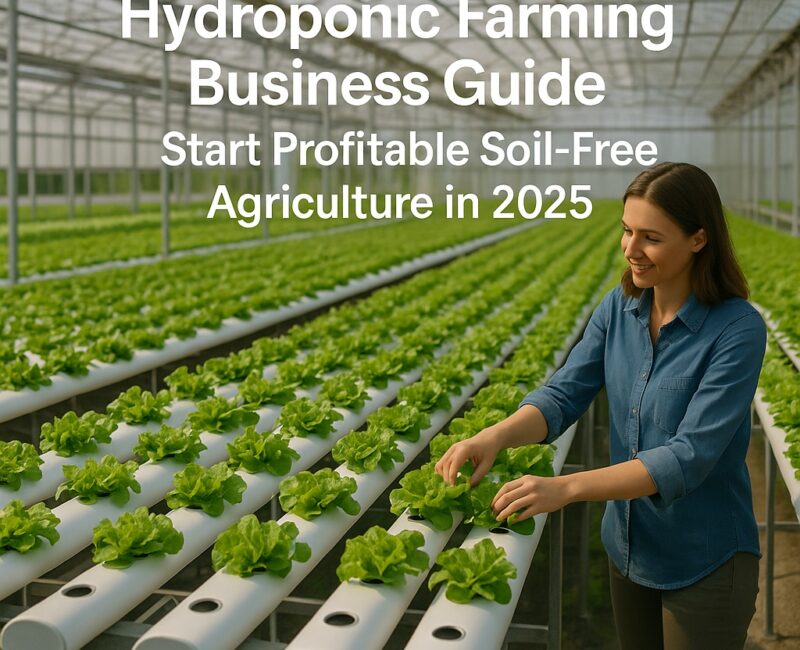Hydroponic farming is booming worldwide—especially in the U.S., U.K., Canada, Germany, and Australia. This soil-free growing method is revolutionizing the agriculture business by allowing higher yields, year-round cultivation, and eco-efficient use of space and resources. If you’re looking for a future-ready farming model, the hydroponic farming business is where innovation meets income!
What is Hydroponic Farming? 🌿
Hydroponics is a method of growing plants without soil by using mineral-rich water solutions. Plants are placed in nutrient-enriched water, sometimes supported by inert media like perlite, coco coir, or clay pellets.
Benefits:
- Faster plant growth
- Water efficiency (up to 90% less than traditional farming)
- Compact setup: ideal for urban and indoor farming
- No soil-borne diseases
Why Hydroponics is a Smart Business in 2025 🌍
The global hydroponics market is projected to surpass $18 billion USD by 2027 source. With climate change, urban expansion, and rising demand for pesticide-free food, this is the perfect time to invest in a hydroponic farming business.
Top regions showing strong market growth:
- United States (California, Florida, New York)
- United Kingdom (London, Manchester)
- Germany & Netherlands
- Canada & Australia
Best Hydroponic Business Models to Try 🚀
1. Leafy Greens & Herbs Farm
Grow high-demand crops like basil, lettuce, spinach, and mint. Perfect for small-to-medium operations.
2. Microgreens Business
Quick turnaround, low space needed, high retail value! Microgreens like arugula, beet greens, and pea shoots are chef favorites.
3. Hydroponic Flower Farming
Tulips, roses, chrysanthemums, and gerberas grow beautifully in hydroponics. Sell to florists, gift stores, and events.
4. Commercial Hydroponic Greenhouse
Ideal for investors or agri-startups. Sell fresh produce to retailers, restaurants, and local markets.
5. DIY Hydroponic Kit Startup
Package and sell hydroponic starter kits to home gardeners, students, and urban dwellers.
What You Need to Get Started 🔧
Tools & Equipment:
- Grow trays or vertical towers
- Nutrient solution reservoir
- Water pump & timer
- pH & EC meter
- Artificial grow lights (LED preferred)
Best Hydroponic Systems:
- Deep Water Culture (DWC)
- Nutrient Film Technique (NFT)
- Ebb & Flow (Flood and Drain)
- Wick system (good for beginners)
Cost Breakdown & ROI 📊
| Item | Approx. Cost (USD) |
|---|---|
| Basic hydroponic setup | $500–$2,000 |
| Greenhouse installation | $5,000–$25,000 |
| Monthly operating costs | $200–$1,000 |
| Crop ROI (lettuce/herbs) | 50%–150% markup |
💡 Pro Tip: Partner with local restaurants and farmer’s markets to sell high-quality fresh produce for premium pricing.
Scaling and Automation 🌐
- Use sensors for real-time data tracking (humidity, temp, pH)
- Automate nutrient delivery & lighting
- Cloud-based dashboards for multi-farm management
- Integrate vertical racks to maximize limited space
Challenges to Expect ⚠️
- Initial setup costs can be high
- Requires consistent monitoring of pH and nutrients
- Power outage risks (backup needed)
- Market education—many still prefer soil-grown
Tips for First-Time Entrepreneurs 🚀
- Start small, scale gradually
- Join hydroponic farming forums & online communities
- Take a short hydroponics course
- Partner with sustainable agriculture grants (check USDA, EU Green Fund, etc.)
Conclusion 🌱
The hydroponic farming business is no longer just a trend—it’s the future of agriculture. With the rising global demand for clean, local, and nutritious food, 2025 is the year to get in. Whether you’re planning to start small at home or scale to a full-fledged commercial farm, hydroponics offers flexibility, profitability, and sustainability.





